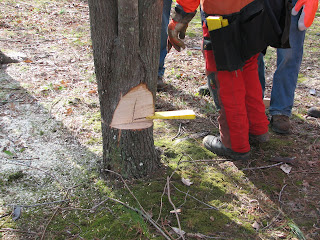
Small trees don't have much room for error when making your cuts, and they can be troublesome to novices who are learning how to use a saw. The front cut came out nicely for this student, who was working from the good (tensioned) side of the tree.

The potential problem came up as he finished his bore cut to establish the hinge. He didn't get off the throttle quickly enough, and the top of his bar cut out half of the hinge. Everything came to a screeching halt so the class could evaluate the situation and to make contingency plans.

Luckily, the missing hinge wood came from the heavy side of the tree. If it had been cut from the tensioned side, the hinge would certainly fail when the tree was cut loose. Because the mis-cut was on the heavy side, a wedge was pounded in to provide support, and the tree fell with the hinge when the back strap was cut.
Remember that the bar likes to pull toward the top when you are making a bore cut, especially in soft woods like this red maple. It is always safer to make your bore cut with extra wood for the hinge, and then carefully reduce the hinge to the proper thickness.
If you blow out the hinge on the tensioned side, the tree is almost certainly going to fall with the lean of the tree, and not the remains of your hinge. Stop and think through your cuts so you don't trap your saw under the heavy side of the tree, and so you can cut the tree loose and make a safe getaway. You may have to clear a new escape path for the new falling direction.
Click Here to review your planning procedure for dropping a tree.
 Small trees don't have much room for error when making your cuts, and they can be troublesome to novices who are learning how to use a saw. The front cut came out nicely for this student, who was working from the good (tensioned) side of the tree.
Small trees don't have much room for error when making your cuts, and they can be troublesome to novices who are learning how to use a saw. The front cut came out nicely for this student, who was working from the good (tensioned) side of the tree. The potential problem came up as he finished his bore cut to establish the hinge. He didn't get off the throttle quickly enough, and the top of his bar cut out half of the hinge. Everything came to a screeching halt so the class could evaluate the situation and to make contingency plans.
The potential problem came up as he finished his bore cut to establish the hinge. He didn't get off the throttle quickly enough, and the top of his bar cut out half of the hinge. Everything came to a screeching halt so the class could evaluate the situation and to make contingency plans. Luckily, the missing hinge wood came from the heavy side of the tree. If it had been cut from the tensioned side, the hinge would certainly fail when the tree was cut loose. Because the mis-cut was on the heavy side, a wedge was pounded in to provide support, and the tree fell with the hinge when the back strap was cut.
Luckily, the missing hinge wood came from the heavy side of the tree. If it had been cut from the tensioned side, the hinge would certainly fail when the tree was cut loose. Because the mis-cut was on the heavy side, a wedge was pounded in to provide support, and the tree fell with the hinge when the back strap was cut. 







No comments:
Post a Comment